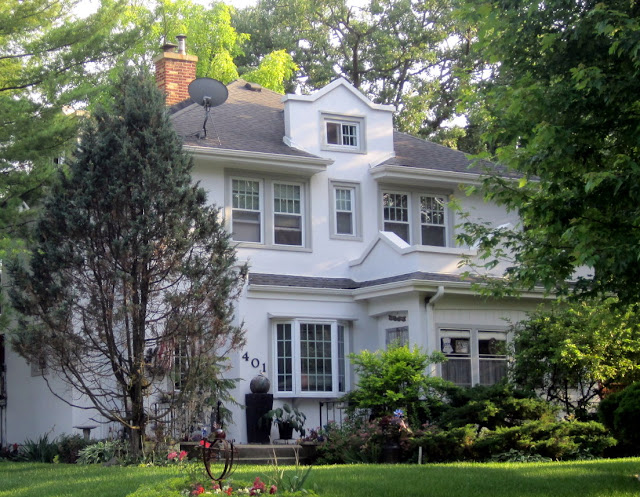The people who worked at Sears Roebuck were masters of marketing. They knew exactly what housing styles would appeal to the vast majority of customers. Sears Roebuck's best-selling models were replicated by other kit home manufacturers, plan book companies, and local builders. These imposters make it difficult for someone to discern which houses are Sears models merely based on visual inspections of the outsides.
We may have an imposter in Mundelein.
 |
| 401 S. Lakeshore Dr., Mundelein. Photo from Lake County Assessor. |
 |
| Sears Alhambra. |
The house in the Diamond Lake subdivision looks like a Sears Alhambra. The Alhambra was a popular Spanish Colonial Revival.
The Spanish-styled parapets may have been replaced--we have seen that happen with other Alhambras in the U.S. The originals from Sears were prone to water damage due to inadequate flashing.
The window and door placements on the front and sides match the catalog illustration, and the little terrace remains in the front. The outside of the house is stucco, the way Sears delivered it. The porch has been enclosed.
The Mundelein house is two feet wider and two feet longer than the Alhambra. Sears would occasionally super-size their houses for customers, but this was an uncommon occurrence.
The living room windows differ in size and shape from the illustration, but these could have been replaced over the years. The living room bumpout with the bay window looks much deeper than that of the Alhambra. The house is missing the decorative molds on the second story, but those also could have been removed at some point.
The house hasn't come up for sale recently, so we cannot see the interior to look for standard Sears elements inside the house, such as door hardware and millwork.
The house has similarities to an Alhambra, but also many differences. "Close enough" is not good enough to definitively identify a house as being from Sears Roebuck.
Can the house history reveal whether the house is a Sears Alhambra or an imposter?
Developers from Chicago, Vacek Bros., purchased 60 acres in Mundelein in the early 1920's and subdivided it. Unlike the surrounding area, the Vacek Bros. development, called Diamond Lake Lodge, would not consist of summer bungalows, but it would be a "high class property" with permanent residences. The development would feature a $20,000 community club house, 18-hole golf course, tennis courts, playgrounds, and lake rights. It does not appear that any of these amenities were ever built, and today there are no traces of them.
 |
| Ad in the Chicago Tribune from June 1924. If you were a person of color, you were not welcome in the Diamond Lake subdivision. |
 |
| The Diamond Lake area today. Photo from Realtor site. |
Vacek Bros. sold the house in Diamond Lake to Jack and Treva McCarthy in November 1926 for $6,000. Sears did sell the Alhambra during that time. We don't have any evidence that the Vaceks purchased a kit from Sears.
The McCarthys sold the house in 1932 and moved to Chicago. None of the McCarthy descendants know anything about the house in Mundelein.
This "Alhambra" has problems, and I'm not adding it to the national database of Sears homes just yet. If you know anything about this house, please email me.
 |
| Jack McCarthy in 1918. Photo from the Chicago Tribune. |
The McCarthys sold the house in 1932 and moved to Chicago. None of the McCarthy descendants know anything about the house in Mundelein.
This "Alhambra" has problems, and I'm not adding it to the national database of Sears homes just yet. If you know anything about this house, please email me.



2 comments:
A true conundrum! Given the popularity of the Alhambra, it would not surprise me to find that similar designs may have ended up in competitor's offerings or in plan books. I guess it is possible that it is a customized version of the Alhambra, but if the subdivision was originally marketed as an upscale area, it doesn't seem likely that one of the earliest houses built would have been a Sears kit house. Definitely a head-scratcher!
You make a solid point in that this was supposed to be a super high-end subdivision. The Vacek brothers probably didn't even know this house was a Sears knockoff.
Post a Comment